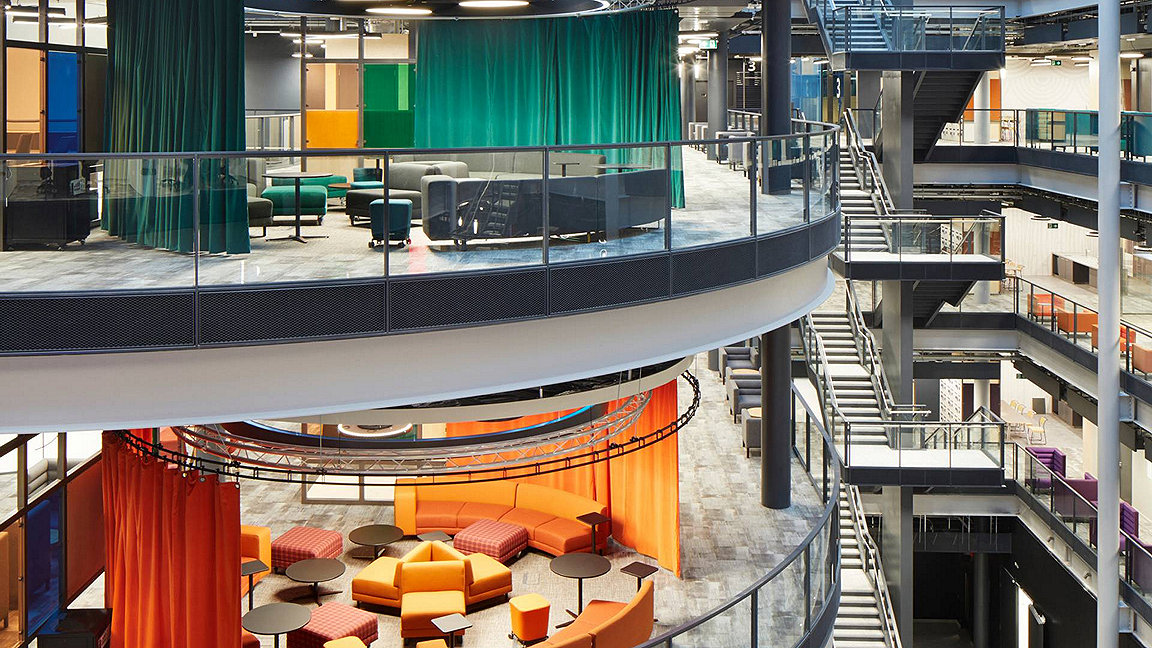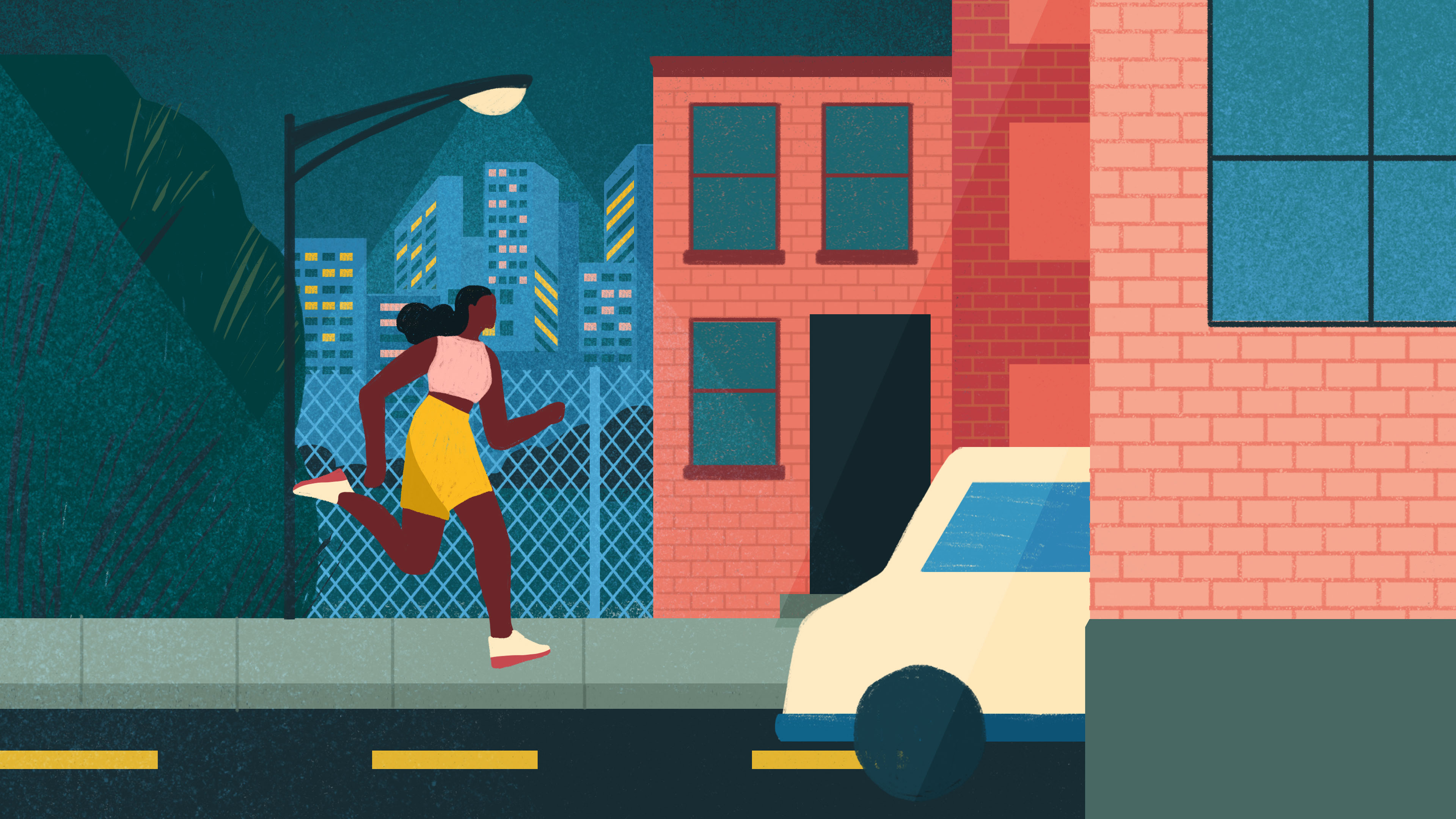
BBC Cymru Wales Broadcast Centre. Photo credit Sheppard Robson / Jack Hobhouse
Many people take navigating a building and feeling comfortable within it for granted. However, for those who are not ‘neurotypical’ this can be problematic.
Between 15% and 20% of the population is thought to have neurodiverse needs. Within this demographic are occupants and visitors to buildings that will include members of the RICS community.
In October 2022, the British Standards Institution (BSI) published PAS 6463. This document defines neurodiversity as “variation of neurocognitive profiles across the whole population”. It marks the first time national guidance has been published for building designers to consider accessibility for neurodiverse needs. Under this interpretation, neurodivergent conditions such as autism, attention deficit hyperactivity disorder (ADHD) and dyspraxia are included, alongside neurodegenerative ones including different forms of dementia and Parkinson’s disease.
A PAS (Publicly Available Specification) contains voluntary guidance on emerging good practice in a field. In this case of PAS 6463, this means guidance on elements including lighting, acoustics, décor, flooring, layout, wayfinding, familiarity, clarity, temperature and smells. Jean Hewitt was PAS 6463’s technical author, working with a steering group of experts.
She is an accessibility and inclusive environments specialist at Buro Happold, as well as holding a voluntary role as the UK Government’s disability and access ambassador for the built environment. “Neurodiversity is one of the biggest areas not currently catered for in building design,” says Hewitt. “Brains have a rich diversity in how they process information and experience the physical environment through the senses. Some people can be hyposensitive and want rich sensory stimulation, whereas others may be hypersensitive and are unable to filter out unwanted stimulation through one or more of the senses.”
That’s not to say that complex patterns or certain types of lighting can’t be incorporated into, say, a workplace interior, it’s more the choice and control of an environment, Hewitt explains. This, along with instilling a sense of calm and clarity of spaces within the building, is central to meeting a spectrum of needs.
Creating zones
Hewitt cites a practical example of BBC Wales Broadcast Centre in Cardiff. Here the glazing of a meeting room featured mountain motifs, which posed potential issues for hypersensitive individuals and so a voile curtain was installed to alleviate the distraction as well as provide privacy.
“It’s not as simple as more daylight or more quiet rooms,” says neurodiversity consultant Emma Marfe, who has 15 years’ experience in international professional services. Among her recommendations is creating zones away from the hustle and bustle of office life, something everyone can really benefit from as workers ebb and flow between individual and collaborative work.
As for the cost of addressing neurodiverse needs, Marfe cites research from the British Dyslexia Association which states that when ‘reasonable adjustments’ are made, there is a marked increase in productivity. And by not providing space where people with ADHD feel comfortable, employers are missing out on the creative talent and problem-solving ability individuals often possess. “One of the biggest impacts for neurodivergent staff is from line managers, so there needs to be training to ensure they are knowledgeable about neurodiversity.”
Marfe has direct experience of being part of an organisational shift, having set up and chaired JLL’s neurodiversity network. This is currently led by Vivek Menon, the company’s executive director of product management and corporate solutions. “Not only are we creating a great organisation for neurodivergent individuals to join and thrive,” says Menon, “we’re also now, from a commercial point of view, offering specific project management, fit out and design services for landlords and occupiers.
“Elements such as lighting are critical and pose a challenge for individuals with autism, dyslexia, or ADHD. The colour palette used is crucial too, you don’t want shades that scream out or distract people. It’s about being more cognisant and considerate of your users.
“How do we make our offices calmer, relaxed and fun?” asks Menon. “Not just spatially but from an experience perspective too, so people are enjoying being in the office and wanting to spend more time there. We’ve been experimenting with biophilia too, it's becoming a norm – it doesn't also have to be about neurodivergent needs, neurotypical staff can benefit as well.”
Sally Augustin, principal at Design with Science, agrees with Menon. “People with ADHD particularly benefit from access to nature,” she says. “People can have issues with any sort of sensory experience, visual or acoustic. Even people who aren't hypo- or hypersensitive or autistic often have issues with sound, from equipment or people nearby, so you really must think about shielding between rooms.”
Designing inclusive spaces
Research organisation Centric Lab worked with PLP Architecture to author a report for the British Council for Offices (BCO) called Designing for Neurodiversity. The report recommends workplace designers consider auditory, thermal, touch and olfactory issues – everything from smells in the kitchen to colleagues’ movement in high traffic areas. It pinpoints 10 key learnings stating, “design can participate in equitability and should be functional and supportive across the intersections of neurodiversity such as class, gender, and racialisation. Design is only one element of an enabling work environment; we must also consider the culture.”
Vanessa Curtis FRICS, senior director with CBRE UK, says: “We always talk about neurodiversity in terms of the physical, the human and the digital: the environment, the design, everything that supports a person, but then also the culture, the policies, the procedures, that people awareness.”
She has a very clear message in terms of managing and developing the built environment: “If we don't improve the diversity profile of our industry, then we will continue to design and construct and build and manage spaces that are not inclusive within our society.”
Curtis is co-founder & co-chair of the AbilityRE network, together with Jennifer Offord. Both neurodiverse people, the pair have made it their mission to make the real estate industry a better place for people of all abilities. AbilityRE is collaborating with some of real estate’s major players to improve policies and procedures around issues such as recruitment processes. “We are working with the governing bodies around best practice. For example, I'm working with Sybil Taunton (head of diversity, equity and inclusion) at the moment on guidelines for RICS.”
Balázs Berecz founder and CEO of Access4you, established certification that rates buildings’ accessibility. It operates across 16 real estate sectors at 1,000 venues in 23 European countries, ranging from offices to restaurants and logistics centres. A wheelchair user for 15 years, Berecz was inspired to create the platform after a frustrating access experience with accommodation in Lisbon. “It provides reliable and detailed data on the locations' accessibility to people with special mobility, visual, hearing, and cognitive needs for free,” he says. The platform’s aim is to help people with disabilities and their families plan ahead.
“We also explore and provide information on topics specifically relevant to people on the autism spectrum: sensory map, social story, sensory room, whether you can adjust temperature, brightness, music in the room. Where these are missing, we give them as suggestions to building owners. Our new Access4you S-score provides certified data that can be included in ESG reports.”
As Jean Hewitt points out, the PAS by its nature is not mandatory but rather it represents early consensus on neurodiversity and the built environment. Having that knowledge sharing in a professional document however – in conjunction with industry steering groups and consultants – can help to create a more sensory inclusive environment for all and hopefully will be a catalyst for further research in this area.
“If we don't improve the diversity profile of our industry, then we will continue to design and construct spaces that are not inclusive” Vanessa Curtis FRICS, CBRE UK
10 key points from the British Council for Offices report, ‘Designing for Neurodiversity’
1. “Neurodiversity is a movement and community, not a diagnosis.”
2. “The conditions that fall under the neurodiversity umbrella cover a wide spectrum, and the lived experiences of these conditions are unique.”
3. “Neurodiversity does not equate to having a ‘special skill’ or a ‘savant’ intelligence. This stereotype is harmful.”
4. “There are biological responses to disabling physical spaces, which can lead to burnout syndrome, the effects of which can be long-lasting and debilitating.”
5. “Burnout syndrome is a highly prevalent condition among the neurodiverse community and plays a key role in unemployment.”
6. “There is a pathway between a disabling space and health.”
7. “Design can participate in equitability and should be functional and supportive across the intersections of neurodiversity, such as class, gender and racialisation.”
8. “Design is only one element of an enabling work environment; we must also consider the culture.”
9. “The physical office space is part of a wider employment ecosystem.”
10. “A key principle of making an environment enabling is to provide people with autonomy through choice and a variety of physical amenities.”

